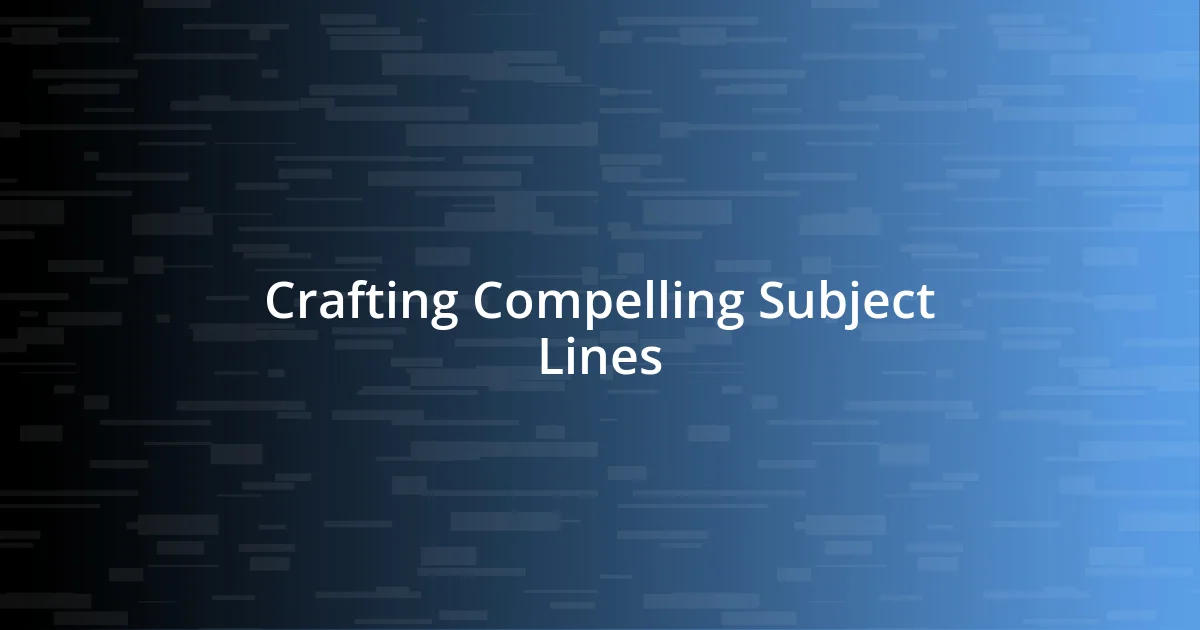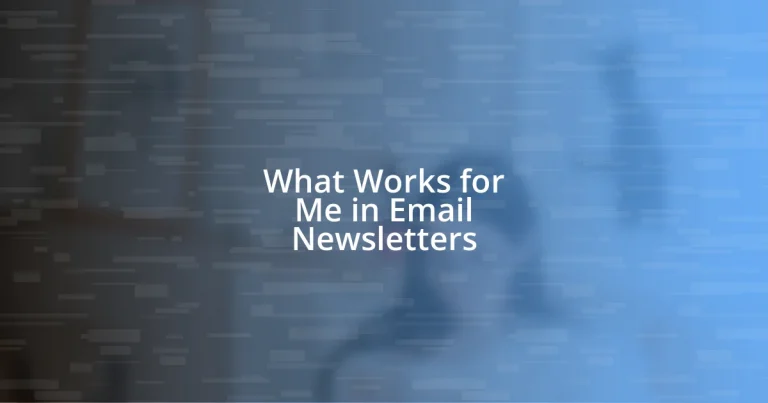Key takeaways:
- Effective email newsletters blend valuable information with a personal touch, enhancing reader engagement through audience segmentation.
- Crafting compelling subject lines through personalization and urgency significantly boosts open rates and engagement.
- Regularly measuring success through metrics and adjusting strategies, along with using the right tools like Mailchimp and Canva, can elevate the overall impact of newsletters.

Understanding Email Newsletters
Email newsletters serve as a direct line of communication between brands and their audiences, often becoming an essential tool for engagement. I remember when I first subscribed to a newsletter from a local coffee shop; every update felt like an invitation to explore their latest brews and events, sparking my interest in a community I hadn’t engaged with before. Isn’t it fascinating how a simple email can create a sense of belonging?
Understanding the structure and content of effective newsletters is crucial. They often blend valuable information with a slice of personality – a balance I strive to find in my own communications. I’ve learned that when a newsletter feels genuine and relatable, like receiving a letter from a friend, it keeps me coming back for more. What if your next email could evoke that same feeling for your readers?
Moreover, the importance of audience segmentation can’t be overstated. Tailoring content to specific groups can dramatically increase engagement. I once conducted an experiment with my own newsletters, dividing my audience into different interest categories, and the response was enlightening: personalized content led to significantly higher click-through rates. How are you approaching your audience needs in your newsletters?

Importance of Targeted Content
A targeted approach in email newsletters transforms how readers perceive content. I’ve seen firsthand how audience interests can shape engagement. The moment I started segmenting my list, crafting content that aligned with specific hobbies and preferences, I noticed a shift in responses. It’s like speaking directly to a friend rather than addressing a crowd; it fosters a connection that can’t be overlooked.
In my experience, delivering tailored content not only resonates better, but it also enhances the overall experience for the reader. For instance, after curating a section specifically for local events in my newsletters, I received emails from subscribers eager to share their experiences. It’s rewarding to know that the content I provide is genuinely valuable to them. Do you see the impact of your targeted content in the responses you get?
Ultimately, connecting on a personal level is about understanding the distinct needs of different readers. By prioritizing targeted content, you’re not only informing but also forming a community around shared interests. I firmly believe that if you tune into what your audience cares about, they’ll reward you with their attention and loyalty.
| Aspect | General Content | Targeted Content |
|---|---|---|
| Engagement Level | Lower | Higher |
| Response Rate | Variable | Consistently Higher |
| Personal Connection | Minimal | Emphasized |

Crafting Compelling Subject Lines
Crafting an enticing subject line can make or break your email newsletter. I still remember when I stumbled upon a subject line that read, “Unlock Exclusive Offers Just for You.” It felt like a secret invitation, and I couldn’t resist clicking. This experience taught me the irresistible power of personalization and urgency. By instilling a sense of curiosity or exclusivity, you can make your readers eager to open that email and discover what lies within.
Here are some tips I find particularly effective in crafting compelling subject lines:
- Use Action Words: Action verbs create a sense of urgency. Instead of “Our New Collection,” try “Discover Our New Collection Today!”
- Personalize Whenever Possible: Including a subscriber’s name or preference can make your email feel tailored just for them.
- Create Intrigue: Posing a question or hinting at valuable content can pique interest, like “What’s the One Thing You’re Missing in Your Routine?”
- Keep it Short: Aim for around 50 characters. This ensures the subject line is fully visible on mobile devices.
- Test and Learn: Don’t hesitate to experiment with different styles and analyze which ones yield the best open rates.
Even small changes can yield significant results, and finding the right formula can turn open rates from mundane to exceptional. When I began incorporating urgency into my subject lines, I saw a noticeable uptick in engagement. There’s something so rewarding about watching your readers respond enthusiastically to your crafted invitations. What strategies will you try in your next campaign?

Designing Engaging Layouts
Creating an engaging layout is crucial for keeping readers interested in your email newsletters. I’ve often found that a clean, visually appealing design can be just as persuasive as the content itself. For example, I once redesigned my newsletter to include more white space, larger images, and clear headings. The response was immediate; subscribers commented on how easy it was to navigate. Does your layout invite readers in or push them away?
When I think about engagement, I realize that mixing different content formats can make a layout truly pop. Incorporating bullet points, images, and even short videos can break up text and cater to various preferences. On one occasion, I included a short infographic alongside my regular content. It surprised me how many subscribers commented positively on that addition. Have you ever experimented with diverse content formats to see how your audience reacts?
Lastly, consistent branding throughout your newsletter isn’t just aesthetic; it’s about recognition and trust. I’ve learned from my own newsletters that using a coherent color scheme and font style helps my audience feel familiar and comfortable with my content. It’s like entering a favorite café; everything feels welcoming and cohesive. How does your branding reflect the personality of your newsletter?

Timing Your Email Sends
Timing plays a crucial role in the success of email newsletters. I’ve noticed that sending my newsletters at the right moment significantly boosts open rates. For instance, I’ve experimented with various sending times, and I found that mid-morning on Wednesdays consistently outperformed other days. It’s fascinating how a small tweak in timing can change the game entirely.
I remember an instance where I scheduled an email for a Friday afternoon, thinking it would carry over into the weekend. To my surprise, it flopped. The lesson? Many people have a “weekend switch” in their minds, and that Friday vibe often means tuning out work-related emails. This experience reinforced my belief that understanding your audience’s behavior can shape your strategy. Have you considered when your subscribers are most likely to engage?
It’s essential to consider the time zone differences too. As someone with an audience spread across different regions, I learned that segmenting my list based on location allowed me to optimize send times further. By doing this, I made sure my content landed in inboxes when readers were most attentive. I truly believe those extra steps in timing can make an enormous difference in connection and engagement. What about you—have you delved into your audience’s timing preferences?

Measuring Success and Adjusting
Measuring success is all about using data to understand what’s working and what’s not. When I first delved into metrics, I was overwhelmed by the numbers. However, focusing on open rates, click-through rates, and subscriber feedback revealed patterns that helped me refine my approach. For instance, after noticing a dip in engagement, I realized I had been sending too much promotional content without enough value. Have you looked closely at your metrics to uncover opportunities for improvement?
Adjusting your strategy based on insights is where the magic happens. I once received a flurry of negative feedback about a specific section in my newsletter. Instead of dismissing that input, I decided to experiment; I removed that section and replaced it with a Q&A that invited more interaction. The response was overwhelmingly positive, and my readers felt more connected. How have you responded to the feedback you’ve collected over time?
Regular A/B testing has also been a game-changer for me. For example, I once tested two different subject lines for the same newsletter, one straightforward and one with a playful twist. The playful one saw a 25% increase in open rates, and from that day forward, I made it a point to infuse more personality into my subject lines. What strategies are you using to keep your newsletter fresh and appealing?

Best Tools for Email Newsletters
Finding the right tools for email newsletters can really elevate your game. I’ve explored several platforms, but I always come back to Mailchimp for its user-friendly interface and robust analytics. I remember the first time I integrated their automation feature; it felt like giving my newsletters a personal touch, allowing me to send tailored messages based on user behavior. Have you tried automating your emails to create a more personalized experience for your readers?
Another tool that has stood out for me is ConvertKit. Its simple yet effective tagging system allows me to segment my audience intelligently. I vividly recall launching a special campaign that reson with a subset of my readers; the targeted content led to higher engagement and even some heartfelt replies. It’s moments like these that remind me just how important it is to know who you’re talking to. What segmentation strategies do you find most effective?
Lastly, I cannot overlook the power of Canva when it comes to creating visually appealing newsletters. The templates they offer have genuinely transformed my approach to design. I still smile when I think about the time I used a vibrant template for a seasonal newsletter, which not only drew in more subscribers but also prompted several responses from readers sharing how much they loved the look. Have you considered how good design influences your reader’s perception of your content?














